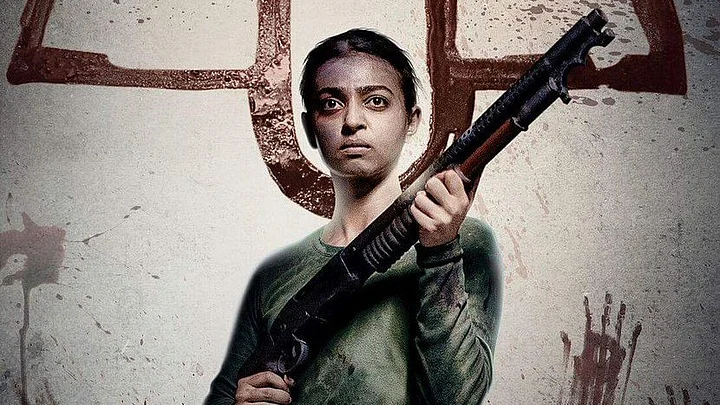Netflix India is ready to mark its entry into the horror genre with its original series, Ghoul starring Radhika Apte. Centred around a mysterious inmate in a high-security prison, the three part mini-series hits the online streaming platform on 24 August.
The official Netflix synopsis reads: Ghoul, a horror series based on Arabic folklore, is set in a covert detention centre. Nida, a newly minted interrogator who turned in her own father as an anti-government activist, arrives at the centre to discover that some of the terrorists held there are not of this world.
The Origins
But who or what are ghouls?
If you, like me, have had enough of vampires and their origins being rewritten in popular culture over and over again, then here’s what you need to know about their neglected step-brothers (or sisters, really) - the ghouls.
The titular “beast” originated in the Arabic folklore. It’s a mythical creature that’s been described as “an evil spirit or phantom, especially one supposed to rob graves and feed on dead bodies” to quench its thirst.
Described among legends as a cross between a spirit and a demon, the ghoul is counted among the evil djinns in Arabic tales - fathered by Iblis, the equivalent of Satan in Qur’an who refused to bow to God, much like Lucifer in the Bible.
Although the ghoul trapped inside the prison in Radhika Apte’s Netflix series is male, researcher Ahmed Al-Rawi defines the ghoul in the Arabic language “as a kind of enchantress, a demon of genies, or the devil itself, since there is no agreement on its specific nature”.
According to Ahmed Al-Rawi in The Mythical Ghoul in Arabic Culture, the existence of ghoul pre-dates Islam. Found in early Mesopotamia folklore, besides the Morrocan ghul, this demonic spirit travelled to Europe when Antoine Galland penned the Arabian Nights.
In countries like Iraq, Palestine and Yemen - ghouls have been used to frighten children since time immemorial.
Morrocan Tales
Folklores in Morocco made famous a she-ghoul named Aysha Qandı¯sha, who is known to be afraid of iron and preys on men. Al-Rawi’s research paper, The Arabic Ghoul and its Western Transformation illustrates her fascinating legend:
Sounds familiar? The upcoming Bollywood film Stree explores a similar urban legend about a she-spirit who preys on men, leaving behind only their clothes.
Palestinian Folktales
Traditionally, stories around the evil spirit revolve around the eternal battle between the human soul and the devil. In Netflix’s Ghoul, too, Radhika Apte’s Nida Rahim is on a quest to extract a confession out of an inmate who appears to possess supernatural powers.
In Ibrahim Muhawi and Sharif Kanaana’s 1989 Palestinian children’s book, ‘Speak Bird, Speak Again: Palestinian Arab Folktales’, there are passing mentions of ghouls. ‘Precious One and Worn-Out’ has a small boy who attempts to kill a ghoul, while ‘Ghaddar the Ghoul and other Palestinian Stories’ by Sonia Nimr has a number of stories revolving around the legend of ghouls.
Western Footprint
The earliest mentions of ghouls beyond West Asia, can be found in Barthelemy d’Herbelot’s (1625–1695) Bibliothe`que orientale, ou Dictionnaire universel, contenanttout ce qui fait connaıˆtre les peuples de l’Orient - known to be the “first encyclopaedia of Islam written in an European language”. As it happens, Antoine Galland assisted d’Herbelot, who eventually brought the idea to Western audiences.
Most of the origin folklores and early Western stories have interpreted the ghoul as female. She-ghoul, Amina has found many a mention among English writers. Charles Dickens describes Amina as “the awful lady, who was a ghoule” in his story, ‘Story of Sidi Nouman’, besides other stray mentions. Even the Charlotte Bronte sisters were arrested with Antoine Galland’s evil “ghoul”.
Al-Rawi observes that most English language writers who portray ghouls as those who “dig graves and eat human corpses”, have interpreted it from Galland’s translation. This, he notes, is in contrast with the idea of Arabian folklore.
Al-Rawi argues that Islam could not shake off these superstitious beliefs that were intrinsic to the Arab culture, their active imaginations, and these “legends” are still very much a phenomenon.
Contemporary Pop Culture
Ghouls are relatively unexploited in popular culture, especially in comparison with vampires. But we do find passing mentions of them in the Harry Potter series, DC Comics, Japanese films and in English literature.
The Japanese film Tokyo Ghoul (2017) revolves around individuals who feed on the flesh of humans and live among them too. JK Rowling’s ‘Harry Potter and the Deathly Hallows’ on the other hand had a ghoul in the Weasley attic, who acted as Ron’s substitute giving us many breathless finger-biting moments.
DC Comics mentions ghouls in its dark comics too. According to DC Fandoms, Ghoul is possibly a distant relative of Scarecrow in the Batman series.
We encountered another variety of evil djinns, Ifrit, in Anushka Sharma’s 2016 horror flick, Pari. Possessing a similar quality in the Bollywood film, Ifrit-worshippers aim to propagate their bloodline by impregnating village women.
Well, horror junkies can only hope that Netflix’s Ghoul captures the imagination of the audience and these beastly creatures conquer popular culture, leaving vampires behind.
(At The Quint, we question everything. Play an active role in shaping our journalism by becoming a member today.)
